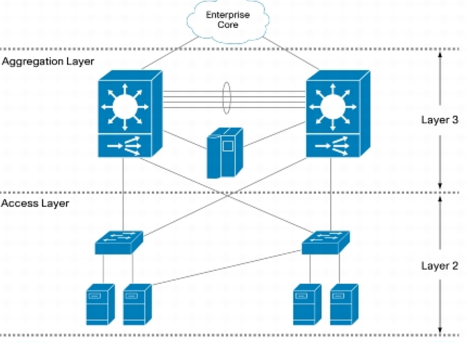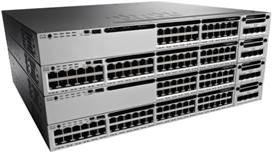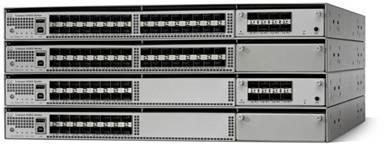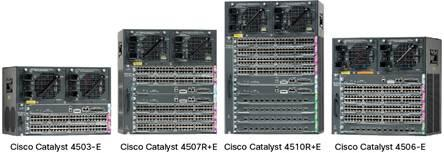Cisco Small Business Switches
It has been a long time to look at the topic, does a typical medium-sized business need an enterprise-class IT infrastructure?
An article for those who gave themselves the answer: “Yes, I need it” and who is interested in how to make the right choice of components based on Cisco solutions.
In the course of this article, we will examine which models of Cisco switches are most relevant for typical tasks of small enterprises. At the same time, we will narrow the circle to companies with a staff of about 250 people.
The focus will be on the choice of network infrastructure as the necessary foundation for the further growth of IT.
Consider the differences between modern lines of Cisco switches and how these differences fit into the Cisco “Networks without Borders” architecture.
')
As a result, a narrow circle of specific models will be determined, which can rightly be considered universal and the most common in its class.
All IT departments are different, and they evolve differently, but often come to the same
Someone stopped at the once created IT infrastructure, over the years it had expanded to the “zoo of everything”, which was acquired and it is a pity to throw it away.
Others appreciated the usefulness of IT investments and build everything from scratch, understanding how IT efficiency will positively affect the business of the enterprise as a whole.
Both the first and second important to understand:
The main brick of any IT infrastructure is a network
The network infrastructure allows you to connect people involved in a common cause, at any distance, to ensure their joint work and the availability of common IT resources. The effectiveness of any employee directly depends on the network performance. And the latter depends on a variety of factors: from the knowledge and motivation of the nearest sysadmin to the objective capabilities of network equipment. We will consider only the part that is subject to an objective assessment - network equipment.
For corporate networks, Cisco - has long been an unconditional standard. Therefore, in the Cisco blog on Habré we will release the “Why Cisco?” Part, leaving it for other places.
For users, the network is an abstract concept. In its closest materialization, it is the outlet / port on the wall where the computer system unit and / or IP phone are connected. On the other hand, it is equipment that allows all users to work in a single network. This function is performed by access switches.
Among the many lines of switches that Cisco offers (Figure 1), small companies should pay attention to the most common Catalyst 2960 series.

Figure 1. Cisco switching solutions for the campus network
Switches in this series have existed for many years and have earned the recognition of users due to the good value for money, quality and functionality. The basic set of functions of switches of this line is quite sufficient for most tasks of a small enterprise. "Basic" - in comparison with other lines of Cisco switches. If we compare it with the functionality of our closest competitors, then we can safely say that such “basic” functionality is comparable to “advanced” from other manufacturers. Cisco always focuses on high-tech availability to ordinary consumers.
Where the functionality of the switches of the line is not enough - you can always add the required number of devices of the older lines. This is usually done in most enterprises.
Modern 100 Mbps switches are represented by the Catalyst 2960 Plus line . Their significant advantage is low price. Of the useful features of this series, there is no stacking capability.
Figure 2 shows the appearance of the switches in this series.

Figure 2. Cisco Catalyst 2960 Plus series.
The most popular models of this line are the WS-C2960 + 24PC-L and WS-C2960 + 48PST-L. Access ports 100 Mbit / s, two uplinks (copper / optics) at 1 Gb / s, power over twisted pair (Power over Ethernet), LanBase firmware - everything that is necessary for normal operation.
Particular attention should also be paid to the WS-C2960 + 24LC-L switch. Power over twisted pair (PoE), it can give only 8 ports, but it costs much cheaper. This is an option for those who are not sure if they need PoE support. Or I am sure that no more than 8 ports will be needed. I would not advise choosing a switchboard without PoE “for growth” with the prospect of service for the next few years. An exception may be only a fully conscious case of such necessity. Otherwise, you will have to find where and how to connect and where to hide the power supply to an IP phone, IP camera, Wi-Fi access point, VDI thin client, etc.
Those who lack 100 Mbps at the access port should be interested in the new Catalyst 2960-X line . The switches of this line are equipped with 1 Gb / s access ports, four copper or 1 Gb / s optical ports for uplinks (or 2 x 10 Gb / s). They all support stacking.
I would like to dwell on the Catalyst 2960-XR switches in more detail. They are equipped with a backup power supply and support basic routing functions (L3 switch, IPLite firmware).
Therefore, anyone who needs a 1 Gbit / s switch with up to 8 devices stacked (for example, to send only uplink from all eight), with support for power over twisted pair (PoE) and basic L3 functions, you should pay attention to the model WS-C2960XR -48FPS-I .
After reviewing the pricing, you can make sure that it is always more profitable to take 48 ports than 24 or less. It will be cheaper in terms of port, more convenient in terms of management, and they also take up less space in the rack. But there are times when 8 or 12 ports are enough. For example, when one office or two adjacent. Or a separate building to which you need to pull the network.
For such cases, Catalyst Compact switches are useful. These are L2 (Catalyst 2960 based) or L3 (Catalyst 3560 based) switches that support PoE on access ports and can be powered via PoE via uplinks.
Figure 3 shows the appearance of the switches in this series.

Figure 3. Cisco Catalyst 2960C / 3560C Compact series.
Cute white body, quiet operation, no need to look for a power outlet make these switches an excellent choice for office space:
WS-C3560CPD-8PT-S (8-ports) L3
WS-C2960CPD-8PT-L (8-ports) L2
WS-C2960C-12PC-L (12-ports) L2
They will help you quickly deploy the network in any room - from a meeting room to a conference room, and also give an additional 100 meters covered by a copper cable (savings on optical connections).
250 people are at least six switches (5 x 48 = 240). Of course, they can all be interconnected and create a single network. But most often they do not. The reasons for this are in the basics of modern network design, which is beyond the scope of this article.
As a rule, these six (or more) switches are connected to a dedicated aggregation switch, which ensures the connectivity of all switches in the network. It is also possible to build a fault-tolerant scheme at the aggregation level by adding one more switch. This is a reasonable investment, since such a node will be a single point of failure for 250+ people (Figure 4).
Aggregation switches provide an opportunity to save on a set of expensive functions (for example, L3), applying them only once at the aggregation level and not using them on access switches.

Figure 4. Wiring diagram of devices access level in the network.
Historically, for many years, typical Catalyst 3750 series switches have been typical aggregation devices. They still have not lost their relevance, but new rulers with more powerful hardware and a much larger set of functions cost the same. Accordingly, we recommend the following models for the level of aggregation:
WS-C3650-24PS-E for the aggregation of copper connections (Figure 5).

Figure 5. Cisco Catalyst 3650 series.
WS-C3850-24S-S for the aggregation of copper and optical connections (Figure 6).

Figure 6. Cisco Catalyst 3850 series.
Here, the unique choice is the Catalyst 4500-X (Figure 7). This is a very productive 1RU switch with 16, 24, 32 1G / 10G ports on board and expandable with modules of 8 ports each.

Figure 7. Cisco Catalyst 4500X series.
The WS-C4500X-24X-ES model is noteworthy: 24 sfp-port 1 / 10G and Enterprise services firmware - this is all that is enough for aggregation and / or the network core.
Switches of this series can be assembled into one virtual device using VSS technology. The feature set is comparable to the modular switches of the Catalyst 4500E series.
If 250 people sit at a distance of 100 m from the server, and / or we need power over a twisted pair UPOE (60W), we need 10G interfaces and 1G optics to aggregate several remote switches and modularity is quite suitable, then it is worth considering the following models ( eight):

Figure 8. Catalyst 4500E Series Switches.
To complete the picture, you can also look at the Catalyst 6xxx line
There are many interesting things: Instant Access architecture, service modules, performance. But this is a topic for a separate article.
Access level switches, 100 Mbps:
● WS-C2960 + 24PC-L (24-ports) L2
● WS-C2960 + 48PST-L (48-ports) L2
Access / Aggregation Level Switch, 1 Gbps:
● WS-C2960XR-48FPS-I (48-ports) L3
Access level switches, compact:
● WS-C3560CPD-8PT-S (8-ports) L3
● WS-C2960CPD-8PT-L (8-ports) L2
● WS-C2960C-12PC-L (12-ports) L2
Aggregation Level Switch, 1 Gbps:
● WS-C3650-24PS-E (24-ports) L3
● WS-C3850-24S-S (24-ports) L3
Core Level Switch, 1/10 Gbps:
● WS-C4500X-24X-ES (24-ports) L3
Modular Aggregation / Core Switches, 1/10 Gbps:
● WS-C4503E-S7L + 48V + (48+ ports) L3
● WS-C4506E-S7L + 96V + (96+ ports) L3
Of course, the list is incomplete and not exhaustive.
For most small businesses, it can be a good start for choosing specific models for their specific tasks.
Cisco experts are always ready to help you with this, as well as our partners.
You can purchase Cisco products or find out pricing information from Cisco partners in Russia and Ukraine .
They will help you choose and implement the best solution for your business.
An article for those who gave themselves the answer: “Yes, I need it” and who is interested in how to make the right choice of components based on Cisco solutions.
In the course of this article, we will examine which models of Cisco switches are most relevant for typical tasks of small enterprises. At the same time, we will narrow the circle to companies with a staff of about 250 people.
The focus will be on the choice of network infrastructure as the necessary foundation for the further growth of IT.
Consider the differences between modern lines of Cisco switches and how these differences fit into the Cisco “Networks without Borders” architecture.
')
As a result, a narrow circle of specific models will be determined, which can rightly be considered universal and the most common in its class.
All IT departments are different, and they evolve differently, but often come to the same
Someone stopped at the once created IT infrastructure, over the years it had expanded to the “zoo of everything”, which was acquired and it is a pity to throw it away.
Others appreciated the usefulness of IT investments and build everything from scratch, understanding how IT efficiency will positively affect the business of the enterprise as a whole.
Both the first and second important to understand:
- what and how to choose as the foundation of the IT infrastructure;
- what will be relevant and useful in the near future;
- how this choice will help make IT more efficient and more useful for business.
The main brick of any IT infrastructure is a network
The network infrastructure allows you to connect people involved in a common cause, at any distance, to ensure their joint work and the availability of common IT resources. The effectiveness of any employee directly depends on the network performance. And the latter depends on a variety of factors: from the knowledge and motivation of the nearest sysadmin to the objective capabilities of network equipment. We will consider only the part that is subject to an objective assessment - network equipment.
"Why Cisco?"
For corporate networks, Cisco - has long been an unconditional standard. Therefore, in the Cisco blog on Habré we will release the “Why Cisco?” Part, leaving it for other places.
Where does the network start?
For users, the network is an abstract concept. In its closest materialization, it is the outlet / port on the wall where the computer system unit and / or IP phone are connected. On the other hand, it is equipment that allows all users to work in a single network. This function is performed by access switches.
Cisco Access Switches
Among the many lines of switches that Cisco offers (Figure 1), small companies should pay attention to the most common Catalyst 2960 series.

Figure 1. Cisco switching solutions for the campus network
Switches in this series have existed for many years and have earned the recognition of users due to the good value for money, quality and functionality. The basic set of functions of switches of this line is quite sufficient for most tasks of a small enterprise. "Basic" - in comparison with other lines of Cisco switches. If we compare it with the functionality of our closest competitors, then we can safely say that such “basic” functionality is comparable to “advanced” from other manufacturers. Cisco always focuses on high-tech availability to ordinary consumers.
Where the functionality of the switches of the line is not enough - you can always add the required number of devices of the older lines. This is usually done in most enterprises.
100 Mbps
Modern 100 Mbps switches are represented by the Catalyst 2960 Plus line . Their significant advantage is low price. Of the useful features of this series, there is no stacking capability.
Figure 2 shows the appearance of the switches in this series.

Figure 2. Cisco Catalyst 2960 Plus series.
The most popular models of this line are the WS-C2960 + 24PC-L and WS-C2960 + 48PST-L. Access ports 100 Mbit / s, two uplinks (copper / optics) at 1 Gb / s, power over twisted pair (Power over Ethernet), LanBase firmware - everything that is necessary for normal operation.
Particular attention should also be paid to the WS-C2960 + 24LC-L switch. Power over twisted pair (PoE), it can give only 8 ports, but it costs much cheaper. This is an option for those who are not sure if they need PoE support. Or I am sure that no more than 8 ports will be needed. I would not advise choosing a switchboard without PoE “for growth” with the prospect of service for the next few years. An exception may be only a fully conscious case of such necessity. Otherwise, you will have to find where and how to connect and where to hide the power supply to an IP phone, IP camera, Wi-Fi access point, VDI thin client, etc.
Good to know
C2960 switches with LanLite firmware are hardware different from their fellows with more functional LanBase. Upgrading from LanLite to Lanbase is not possible.
LanLite is cheaper due to a strictly limited set of functions. For example, port authentication technologies (trustsec) and media stream management (medianet) on switches with LanLite will not work fully. Reduced the number of VLANs and other rather important characteristics. LanLite is just a switch-port from Cisco.
For modern networks, I would not recommend considering the LanLite model, as well as the Cisco SMB line. These are extreme options for compromising price and functionality.
LanLite is cheaper due to a strictly limited set of functions. For example, port authentication technologies (trustsec) and media stream management (medianet) on switches with LanLite will not work fully. Reduced the number of VLANs and other rather important characteristics. LanLite is just a switch-port from Cisco.
For modern networks, I would not recommend considering the LanLite model, as well as the Cisco SMB line. These are extreme options for compromising price and functionality.
1 Gbps
Those who lack 100 Mbps at the access port should be interested in the new Catalyst 2960-X line . The switches of this line are equipped with 1 Gb / s access ports, four copper or 1 Gb / s optical ports for uplinks (or 2 x 10 Gb / s). They all support stacking.
I would like to dwell on the Catalyst 2960-XR switches in more detail. They are equipped with a backup power supply and support basic routing functions (L3 switch, IPLite firmware).
Therefore, anyone who needs a 1 Gbit / s switch with up to 8 devices stacked (for example, to send only uplink from all eight), with support for power over twisted pair (PoE) and basic L3 functions, you should pay attention to the model WS-C2960XR -48FPS-I .
Compact Switches
After reviewing the pricing, you can make sure that it is always more profitable to take 48 ports than 24 or less. It will be cheaper in terms of port, more convenient in terms of management, and they also take up less space in the rack. But there are times when 8 or 12 ports are enough. For example, when one office or two adjacent. Or a separate building to which you need to pull the network.
For such cases, Catalyst Compact switches are useful. These are L2 (Catalyst 2960 based) or L3 (Catalyst 3560 based) switches that support PoE on access ports and can be powered via PoE via uplinks.
Figure 3 shows the appearance of the switches in this series.

Figure 3. Cisco Catalyst 2960C / 3560C Compact series.
Cute white body, quiet operation, no need to look for a power outlet make these switches an excellent choice for office space:
WS-C3560CPD-8PT-S (8-ports) L3
WS-C2960CPD-8PT-L (8-ports) L2
WS-C2960C-12PC-L (12-ports) L2
They will help you quickly deploy the network in any room - from a meeting room to a conference room, and also give an additional 100 meters covered by a copper cable (savings on optical connections).
Aggregation Switches
250 people are at least six switches (5 x 48 = 240). Of course, they can all be interconnected and create a single network. But most often they do not. The reasons for this are in the basics of modern network design, which is beyond the scope of this article.
As a rule, these six (or more) switches are connected to a dedicated aggregation switch, which ensures the connectivity of all switches in the network. It is also possible to build a fault-tolerant scheme at the aggregation level by adding one more switch. This is a reasonable investment, since such a node will be a single point of failure for 250+ people (Figure 4).
Aggregation switches provide an opportunity to save on a set of expensive functions (for example, L3), applying them only once at the aggregation level and not using them on access switches.

Figure 4. Wiring diagram of devices access level in the network.
Historically, for many years, typical Catalyst 3750 series switches have been typical aggregation devices. They still have not lost their relevance, but new rulers with more powerful hardware and a much larger set of functions cost the same. Accordingly, we recommend the following models for the level of aggregation:
WS-C3650-24PS-E for the aggregation of copper connections (Figure 5).

Figure 5. Cisco Catalyst 3650 series.
WS-C3850-24S-S for the aggregation of copper and optical connections (Figure 6).

Figure 6. Cisco Catalyst 3850 series.
10G core?
Here, the unique choice is the Catalyst 4500-X (Figure 7). This is a very productive 1RU switch with 16, 24, 32 1G / 10G ports on board and expandable with modules of 8 ports each.

Figure 7. Cisco Catalyst 4500X series.
The WS-C4500X-24X-ES model is noteworthy: 24 sfp-port 1 / 10G and Enterprise services firmware - this is all that is enough for aggregation and / or the network core.
Switches of this series can be assembled into one virtual device using VSS technology. The feature set is comparable to the modular switches of the Catalyst 4500E series.
Modular?
If 250 people sit at a distance of 100 m from the server, and / or we need power over a twisted pair UPOE (60W), we need 10G interfaces and 1G optics to aggregate several remote switches and modularity is quite suitable, then it is worth considering the following models ( eight):
- Pairs of such devices and only three expansion slots can be enough for reliable and productive core / aggregation: bundle WS-C4503E-S7L + 48V +
- If it is necessary to reduce all network facilities to one server: WS-C4506E-S7L + 96V + bundle and the pair will solve all the problems to it. Variants of the filling will allow you to choose everything you need.

Figure 8. Catalyst 4500E Series Switches.
To complete the picture, you can also look at the Catalyst 6xxx line
There are many interesting things: Instant Access architecture, service modules, performance. But this is a topic for a separate article.
Models that can be considered modern, optimal and universal for their class of tasks
Access level switches, 100 Mbps:
● WS-C2960 + 24PC-L (24-ports) L2
● WS-C2960 + 48PST-L (48-ports) L2
Access / Aggregation Level Switch, 1 Gbps:
● WS-C2960XR-48FPS-I (48-ports) L3
Access level switches, compact:
● WS-C3560CPD-8PT-S (8-ports) L3
● WS-C2960CPD-8PT-L (8-ports) L2
● WS-C2960C-12PC-L (12-ports) L2
Aggregation Level Switch, 1 Gbps:
● WS-C3650-24PS-E (24-ports) L3
● WS-C3850-24S-S (24-ports) L3
Core Level Switch, 1/10 Gbps:
● WS-C4500X-24X-ES (24-ports) L3
Modular Aggregation / Core Switches, 1/10 Gbps:
● WS-C4503E-S7L + 48V + (48+ ports) L3
● WS-C4506E-S7L + 96V + (96+ ports) L3
Of course, the list is incomplete and not exhaustive.
For most small businesses, it can be a good start for choosing specific models for their specific tasks.
Cisco experts are always ready to help you with this, as well as our partners.
You can purchase Cisco products or find out pricing information from Cisco partners in Russia and Ukraine .
They will help you choose and implement the best solution for your business.
Source: https://habr.com/ru/post/244775/
All Articles